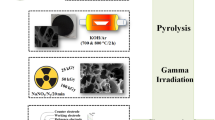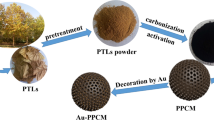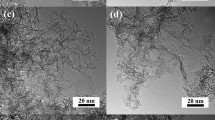Abstract
Fast ionic transport in microporous activated-carbon electrodes is a prerequisite for the effective energy storage in electrochemical supercapacitors1,2. However, the quartz-crystal microbalance3,4,5,6,7,8 (QCM), a direct tool to measure ionic fluxes in electrochemical systems, has not yet been used for studying transport phenomena in activated carbons (except for an early report on carbon nanotubes9). Conventional electroanalytical1 and suitable surface and structure-analysis techniques10,11,12 provide limited prognostic information on this matter. It has been demonstrated herein that the QCM response of typical microporous activated carbons can serve as a gravimetric probe of the concentration and compositional changes in their pore volume. This allowed direct monitoring of the ionic fluxes, which depended strongly on the electrode’s point of zero change, pore width, ion size and cycling conditions (polarization amplitude, charge/discharge depth and so on). The information on the nature of ionic fluxes into activated carbons is critical for promoting improvements in the performance of electrochemical supercapacitors, membrane technologies and (electro/bio)chemical sensors.
This is a preview of subscription content, access via your institution
Access options
Subscribe to this journal
Receive 12 print issues and online access
$259.00 per year
only $21.58 per issue
Buy this article
- Purchase on Springer Link
- Instant access to full article PDF
Prices may be subject to local taxes which are calculated during checkout



Similar content being viewed by others
References
Conway, B. E. Electrochemical Supercapacitors—Scientific Fundamentals and Technological Applications (Kluwer, 1999).
Simon, P. & Gogotsi, Y. Materials for electrochemical capacitors. Nature Mater. 7, 845–854 (2008).
Ward, M. D. & Buttry, D. A. In situ interfacial mass detection with piezoelectric transducers. Science 249, 1000–1007 (1990).
Wolfbeis, O. S. (ed.) in Piezoelectric Sensors (eds Steinem, C. & Janshoff, A.) (Springer Series on Chemical Sensors and Biosensors. Methods and Applications. Vol. 5, Springer, 2006).
Arnau, A. (ed.) Piezoelectric Transducers and Applications (Springer, 2008).
Bandey, H. L., Hillman, A. R., Brown, M. J. & Martin, S. J. Viscoelastic characterization of electroactive polymer films at the electrode/solution interface. Faraday Discuss. 107, 105–121 (1997).
Johannsmann, D., Mathauer, K., Wegner, G. & Knoll, W. Viscoelastic properties of thin films probed with a quartz-crystal resonator. Phys. Rev. B 46, 7808–7815 (1992).
Daikhin, L. et al. Influence of roughness on the admittance of the quartz crystal microbalance immersed in liquids. Anal. Chem. 74, 554–561 (2002).
Barisci, J. N., Wallace, G. G. & Baughman, R. H. Electrochemical quartz crystal microbalance studies of single-wall carbon nanotubes in aqueous and non-aqueous solutions. Electrochim. Acta 46, 509–517 (2000).
Bonhomme, F., Lassegues, J. C. & Servant, L. Raman spectroelectrochemistry of a carbon supercapacitor. J. Electrochem. Soc. 148, E450–E458 (2001).
Hahn, M. et al. Interfacial capacitance and electronic conductance of activated carbon double-layer electrodes. Electrochem. Solid State Lett. 7, A33–A36 (2004).
Hahn, M., Barbieri, G. & Kötz, R. A dilatometric study of the voltage limitation of carbonaceous electrodes in aprotic EDLC type electrolytes by charge-induced strain. Carbon 44, 2523–2533 (2006).
Etchenique, R. & Brudny, V. L. Characterization of porous polyaniline–polystyrenesulfonate composite films using EQCM. Electrochem. Commun. 1, 441–444 (1999).
Etchenique, R. & Brudny, V. L. Characterization of porous thin films using quartz crystal shear resonators. Langmuir 16, 5064–5071 (2000).
Kastening, B. & Heins, M. Properties of electrolytes in the micropores of activated carbon. Electrochim. Acta 50, 2487–2498 (2005).
Chmiola, J. et al. Anomalous increase in carbon capacitance at pore sizes less than 1 nanometer. Science 313, 1760–1763 (2006).
Ka, B. H. & Oh, S. M. Electrochemical activation of expanded graphite electrode for electrochemical capacitor. J. Electrochem. Soc. 155, A685–A692 (2008).
Eliad, L., Salitra, G., Soffer, A. & Aurbach, D. Ion sieving effects in the electrical double layer of porous carbon electrodes: Estimating effective ion size in electrolytic solutions. J. Phys. Chem. B 105, 6880–6887 (2001).
Mysyk, R., Raymundo-Pinero, E. & Beguin, F. Saturation of subnanometre pores in an electric double-layer capacitor. Electrochem. Commun. 11, 554–556 (2009).
Bruckenstein, S., Brzezinska, K. & Hillman, A. R. EQCM studies of polypyrrole films. Part 2. Exposure to aqueous sodium tosylate solutions under thermodynamically non-permselective conditions. Phys. Chem. Chem. Phys. 2, 1221–1229 (2000).
Muller, E. A., Rull, L. F., Vega, L. F. & Gubbins, K. E. Adsorption of water on activated carbons: A molecular simulation study. J. Phys. Chem. 100, 1189–1196 (1996).
Aurbach, D. et al. Cation trapping in highly porous carbon electrodes for EDLC cells. J. Electrochem. Soc. 155, A745–A753 (2008).
Acknowledgements
This work was supported by the GIF (German-Israel Foundation).
Author information
Authors and Affiliations
Corresponding author
Supplementary information
Supplementary Information
Supplementary Information (PDF 1743 kb)
Rights and permissions
About this article
Cite this article
Levi, M., Salitra, G., Levy, N. et al. Application of a quartz-crystal microbalance to measure ionic fluxes in microporous carbons for energy storage. Nature Mater 8, 872–875 (2009). https://doi.org/10.1038/nmat2559
Received:
Accepted:
Published:
Issue Date:
DOI: https://doi.org/10.1038/nmat2559
This article is cited by
-
Developing in situ electron paramagnetic resonance characterization for understanding electron transfer of rechargeable batteries
Nano Research (2023)
-
Water electrolysis
Nature Reviews Methods Primers (2022)
-
Modeling galvanostatic charge–discharge of nanoporous supercapacitors
Nature Computational Science (2021)
-
Reversible insertion/extraction of polysulfides into/from polyaniline as an effective strategy to confine polysulfides in lithium-sulfur batteries
Ionics (2020)
-
Salt concentration and charging velocity determine ion charge storage mechanism in nanoporous supercapacitors
Nature Communications (2018)



